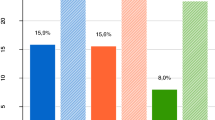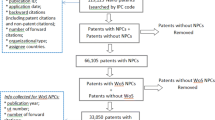Abstract
Patent and scientific literature are the fundamental sources of innovation in knowledge creation and transfer activities. Establishing and understanding the complex relationships between them can help scientists and stakeholders to predict and promote the innovation process. In this paper, we consider the domain of nanoscience, using a large scale collection of patents and scientific literature to find evolution patterns and distinctive keywords of each topic in a particular period. By extracting the semantic-level topics from a dataset of nearly 810,000 scientific literature from Web of Science and 160,000 patents from Derwent, the results reveal that the degree of topic popularity for both innovative platforms shows a totally different situation during the last 20 years from 1995 to 2015. In addition, the top keywords of patents and scientific literature, representing the topic content of concern, have changed respectively as time went on. Not only our analysis can be used for confirming existing topics in nanoscience, but it also gives new views on the relationship between scientific literature and patents.




Similar content being viewed by others
References
Bassecoulard, E., & Zitt, M. (2004). Patents and publications. In Handbook of quantitative science and technology research (pp. 665–694). Netherlands: Springer.
Bhattacharya, S., Kretschmer, H., & Meyer, M. (2003). Characterizing intellectual spaces between science and technology. Scientometrics, 58(2), 369–390.
Blei, D. M., Ng, A. Y., & Jordan, M. I. (2003). Latent dirichlet allocation. Journal of Machine Learning Research, 3, 993–1022.
Branstetter, L., & Ogura, Y. (2005). Is academic science driving a surge in industrial innovation? Evidence from patent citations (No. w11561). National Bureau of Economic Research.
Caraça, J., Lundvall, B. Å., & Mendonça, S. (2009). The changing role of science in the innovation process: From Queen to Cinderella? Technological Forecasting and Social Change, 76(6), 861–867.
Cohen, J., Cohen, P., West, S. G., & Aiken, L. S. (2013). Applied multiple regression/correlation analysis for the behavioral sciences. London: Routledge.
Di Stefano, G., Gambardella, A., & Verona, G. (2012). Technology push and demand pull perspectives in innovation studies: Current findings and future research directions. Research Policy, 41(8), 1283–1295.
Dobson, J. (2006). Gene therapy progress and prospects: Magnetic nanoparticle-based gene delivery. Gene Therapy, 13(4), 283.
Gibbons, M., & Johnston, R. (1974). The roles of science in technological innovation. Research Policy, 3(3), 220–242.
Glänzel, W., & Meyer, M. (2003). Patents cited in the scientific literature: An exploratory study of ‘reverse’ citation relations. Scientometrics, 58(2), 415–428.
Griffiths, T. L., & Steyvers, M. (2004). Finding scientific topics. Proceedings of the National Academy of Sciences of the United States of America, 101(Suppl 1(1)), 5228–5235.
Guan, J., & Zhao, Q. (2013). The impact of university–industry collaboration networks on innovation in nanobiopharmaceuticals. Technological Forecasting & Social Change, 80(7), 1271–1286.
Habibi, Y., Lucia, L. A., & Rojas, O. J. (2010). Cellulose nanocrystals: Chemistry, self-assembly, and applications. Chemical Reviews, 110(6), 3479–3500.
Hassan, M. H. (2005). Small things and big changes in the developing world. Science, 309(5731), 65–66.
Hsu, C.-W., Lien, Y.-C., & Chen, H. (2015). R&D internationalization and innovation performance. International Business Review, 24(2), 187–195.
Hu, D., Chen, H., Huang, Z., & Roco, M. C. (2007). Longitudinal study on patent citations to academic research articles in nanotechnology (1976–2004). Journal of Nanoparticle Research, 9(4), 529–542.
Hu, B., Dong, X., Zhang, C., Bowman, T. D., Ding, Y., Milojević, S., et al. (2015). A lead–lag analysis of the topic evolution patterns for preprints and publications. Journal of the Association for Information Science and Technology, 66(12), 2643–2656.
Huang, C., Notten, A., & Rasters, N. (2011). Nanoscience and technology publications and patents: A review of social science studies and search strategies. The Journal of Technology Transfer, 36(2), 145–172.
Huang, M.-H., Yang, H.-W., & Chen, D.-Z. (2015). Industry–academia collaboration in fuel cells: A perspective from paper and patent analysis. Scientometrics, 105(2), 1301–1318.
Hullmann, A. (2008). European activities in the field of ethical, legal and social aspects (ELSA) and governance of nanotechnology (p. 1). Brussels: European Commission.
Hullmann, A., & Meyer, M. (2003). Publications and patents in nanotechnology. Scientometrics, 58(3), 507–527.
Igami, M., & Okazaki, T. (2007). Capturing nanotechnology’s current state of development via analysis of patents. OECD science, technology and industry working papers.
Kostoff, R. N., Koytcheff, R. G., & Lau, C. G. Y. (2007). Technical structure of the global nanoscience and nanotechnology literature. Journal of Nanoparticle Research, 9(5), 701–724.
Li, R., Chambers, T., Ding, Y., Zhang, G., & Meng, L. (2014). Patent citation analysis: Calculating science linkage based on citing motivation. Journal of the Association for Information Science and Technology, 65(5), 1007–1017.
Li, X., Hu, D., Dang, Y., Chen, H., Roco, M. C., Larson, C. A., et al. (2009). Nano mapper: An Internet knowledge mapping system for nanotechnology development. Journal of Nanoparticle Research, 11(3), 529–552.
Li, X., Lin, Y., Chen, H., & Roco, M. C. (2007). Worldwide nanotechnology development: A comparative study of USPTO, EPO, and JPO patents (1976–2004). Journal of Nanoparticle Research, 9(6), 977–1002.
Logothetidis, S. (Ed.). (2012). Nanostructured materials and their applications. New York: Springer.
Maine, E., Thomas, V. J., Bliemel, M., Murira, A., & Utterback, J. (2014). The emergence of the nanobiotechnology industry. Nature Nanotechnology, 9(1), 2–5.
Makri, M., Hitt, M. A., & Lane, P. J. (2010). Complementary technologies, knowledge relatedness, and invention outcomes in high technology mergers and acquisitions. Strategic Management Journal, 31(6), 602–628.
Mansfield, E. (1991). Academic research and industrial innovation. Research Policy, 20(1), 1–12.
McINTYRE, R. A. (2012). Common nano-materials and their use in real world applications. Science Progress, 95(1), 1–22.
Mei, Q., & Zhai, C. (2005, August). Discovering evolutionary theme patterns from text: An exploration of temporal text mining. In Proceedings of the eleventh ACM SIGKDD international conference on knowledge discovery in data mining (pp. 198–207). ACM.
Meyer, M. (2000a). Does science push technology? Patents citing scientific literature. Research Policy, 29(3), 409–434.
Meyer, M. (2000b). What is special about patent citations? Differences between scientific and patent citations. Scientometrics, 49(1), 93–123.
Meyer, M. (2002). Tracing knowledge flows in innovation systems. Scientometrics, 54(2), 193–212.
Meyer, M. (2006). Knowledge integrators or weak links? an exploratory comparison of patenting researchers with their non-inventing peers in nano-science and technology. Scientometrics, 68(3), 545–560.
Nallapati, R., Shi, X., McFarland, D. A., Leskovec, J., & Jurafsky, D. (2011, July). LeadLag LDA: Estimating topic specific leads and lags of information outlets. In ICWSM.
Narin, F., Hamilton, K. S., & Olivastro, D. (1997). The increasing linkage between US technology and public science. Research Policy, 26(3), 317–330.
National Research Council. (2012). Rising to the challenge: US innovation policy for the global economy. Washington DC: National Academies Press.
Nemet, G. F. (2009). Demand-pull, technology-push, and government-led incentives for non-incremental technical change. Research Policy, 38(5), 700–709.
Nightingale, P. (1998). A cognitive model of innovation. Research policy, 27(7), 689–709.
Ozcan, S., & Islam, N. (2017). Patent information retrieval: Approaching a method and analysing nanotechnology patent collaborations. Scientometrics, 111(2), 1–30.
Ozin, G. A., & Cademartiri, L. (2009). Nanochemistry: What is next? Small (Weinheim an der Bergstrasse, Germany), 5(11), 1240–1244.
Panyam, J., & Labhasetwar, V. (2003). Biodegradable nanoparticles for drug and gene delivery to cells and tissue. Advanced Drug Delivery Reviews, 55(3), 329–347.
Paull, R., Wolfe, J., Hébert, P., & Sinkula, M. (2003). Investing in nanotechnology. Nature Biotechnology, 21(10), 1144–1147.
Porter, A. L., Youtie, J., Shapira, P., & Schoeneck, D. J. (2008). Refining search terms for nanotechnology. Journal of Nanoparticle Research, 10(5), 715–728.
Řehůřek, R., & Sojka, P. (2010). Software framework for topic modelling with large corpora. In Proceedings of the LREC 2010 workshop on new challenges for NLP frameworks (pp. 45–50).
Rip, A. (1992). Science and technology as dancing partners. In Technological development and science in the industrial age (pp. 231–270). Dordrecht: Springer.
Roco, M. C., & Bainbridge, W. S. (2005). Societal implications of nanoscience and nanotechnology: Maximizing human benefit. Journal of Nanoparticle Research, 7(1), 1–13.
Roco, M. C., Mirkin, C. A., & Hersam, M. C. (2011). Nanotechnology research directions for societal needs in 2020: Summary of international study. Journal of Nanoparticle Research, 13(3), 897–919.
Sampat, B. N., & Ziedonis, A. A. (2004). Patent citations and the economic value of patents. In Handbook of quantitative science and technology research (pp. 277–298). Netherlands: Springer.
Selin, C. (2007). Expectations and the emergence of nanotechnology. Science, Technology and Human Values, 32(2), 196–220.
Shaparenko, B., Caruana, R., Gehrke, J., & Joachims, T. (2005). Identifying temporal patterns and key players in document collections. In Proceedings of the IEEE ICDM workshop on temporal data mining: Algorithms, theory and applications (TDM-05) (pp. 165–174).
Shi, X., Nallapati, R., Leskovec, J., McFarland, D., & Jurafsky, D. (2010). Who leads whom: Topical lead–lag analysis across corpora. In NIPS workshop.
Stevens, S. Y., Sutherland, L. M., & Krajcik, J. S. (2009). The big ideas of nanoscale science and engineering. NSTA press.
Swan, R., & Jensen, D. (2000, August). Timemines: Constructing timelines with statistical models of word usage. In KDD-2000 workshop on text mining (pp. 73–80).
Tanaka, M. (2013). Toward a proposed ontology for nanoscience. In Proceedings of the Annual Conference of CAIS/Actes du congrès annuel de l'ACSI, October.
Tussen, R., Buter, R., & Van Leeuwen, T. (2000). Technological relevance of science: An assessment of citation linkages between patents and research papers. Scientometrics, 47(2), 389–412.
Verbeek, A., Debackere, K., Luwel, M., Andries, P., Zimmermann, E., & Deleus, F. (2002). Linking science to technology: Using bibliographic references in patents to build linkage schemes. Scientometrics, 54(3), 399–420.
Wohlleben, W., Kuhlbusch, T. A., Schnekenburger, J., & Lehr, C. M. (Eds.). (2014). Safety of nanomaterials along their lifecycle: Release, exposure, and human hazards. Boca Raton: CRC Press.
Wolfram, J., Zhu, M., Yang, Y., Shen, J., Gentile, E., Paolino, D., et al. (2015). Safety of nanoparticles in medicine. Current Drug Targets, 16(14), 1671–1681.
Zhang, G., Feng, Y., Yu, G., Liu, L., & Hao, Y. (2017). Analyzing the time delay between scientific research and technology patents based on the citation distribution model. Scientometrics, 111, 1–20.
Zitt, M., & Bassecoulard, E. (2006). Delineating complex scientific fields by an hybrid lexical-citation method: An application to nanosciences. Information Processing & Management, 42(6), 1513–1531.
Acknowledgements
This work is supported in part by Major Projects of National Social Science Foundation of China (No. 14ZDA063).
Author information
Authors and Affiliations
Corresponding author
Rights and permissions
About this article
Cite this article
Qi, Y., Zhu, N., Zhai, Y. et al. The mutually beneficial relationship of patents and scientific literature: topic evolution in nanoscience. Scientometrics 115, 893–911 (2018). https://doi.org/10.1007/s11192-018-2693-y
Received:
Published:
Issue Date:
DOI: https://doi.org/10.1007/s11192-018-2693-y




